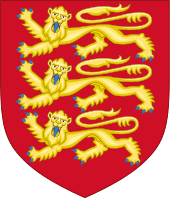History of Derbyshire
The origins of Derbyshire
Derbyshire is first mentioned in the Anglo-Saxon Chronicle in 1048 [1] in Manuscript D of the Chronicle known as the “Northern Recension”. Its creation appears to be a result of the dismemberment of the Mercian Kingdom's province of the Peak District and the chronicle says, under 1048: “her wæs eac eorðstyrung on Kalendas Maias on manegum stowum, on Wygracestre on Wic on Deorby elles gehwær, eac wæs swiðe mycel mancwealm orfcwealm, eac þæt wilde fyr on Deorbyscire micel yfel dyde gehwær elles.” ("This year also there was an earthquake, on the calends of May, in many places; at Worcester, at Wick, and at Derby, and elsewhere wide throughout England; with very great loss by disease of men and of cattle over all England; and the wild fire in Derbyshire and elsewhere did much harm") [2].
Some old sources wrongly refer to a charter from 926 for land at Hope and Ashford as being “in Derbyshire” but the original of the charter does not say Derbyshire, it just says Hope and Ashford. On the other hand, the later and final appearance of the Mercian Kingdoms' province of the Peak District occurs in a charter of King Edgar in 963, where land at Ballidon near Wirksworth is being granted. This charter refers to the land as being “in pago Pecset” not "on Deorbyscire". [3]
Administrative change of the Mercian provinces is often attributed to King Edgar and if this were so then his charters would reflect it, but the Ballidon charter of 963 doesn't. Therefore, it is more likely that the shiring of Derbyshire and the dismemberment of the Pecsaete took place after 975 in the reign of Aethelred the Unready [4] with the remainder of the Peak District being hived off to Nottinghamshire (two hundreds); Cheshire (one hundred) and Staffordshire (one, possibly two, hundreds), the remaining seven forming Derbyshire.
Medieval and later Derbyshire
Derbyshire was traditionally divided into Hundreds or Wapentakes (later), namely Appletree, High Peak, Morleyston and Litchurch, Repton and Gresley, Scarsdale, Wirksworth (whose hundred was also known as the Hamenstan Hundred early in its development). These were based on the seven earlier hundreds recorded in the Domesday Book, with a merging of Repton and Gresley taking place, among other gradual changes in the Hundred or Wapentake names.
Derbyshire had a detached part in north-western Leicestershire, surrounding Measham and Donisthorpe. This escaped regularisation in 1844, and was incorporated into Leicestershire in 1888 when the county councils were set up. The thin strip of Leicestershire between the exclave and Derbyshire, containing Overseal and Netherseal, is now considered part of Derbyshire.
Apart from this, some parishes in historic Derbyshire, including Dore, Norton and Totley, are now in the City of Sheffield in South Yorkshire, having formerly been in the Scarsdale Wapentake.
See also
References
- "Manuscript D: Cotton Tiberius B.iv". asc.jebbo.co.uk. Archived from the original on 2014-04-19. Retrieved 2018-08-08.
- "Britannia: The AngloSaxon Chronicle". www.britannia.com. Archived from the original on 2018-01-04. Retrieved 2018-08-08.
- Brooks, Nicholas (1984). 'A New Charter of King Edgar' in Anglo-Saxon England Vol 13. pp. 137–155.
- Roach, Levi (2016). Aethelred the Unready. New Haven: Yale University Press. pp. 25–30.
